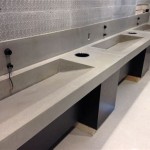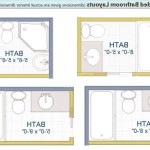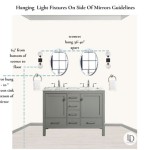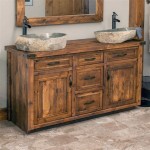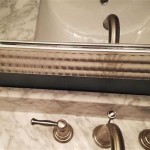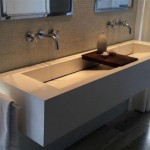96 Inch Bathroom Vanity Double Sink: A Comprehensive Guide
A 96-inch bathroom vanity with a double sink represents a significant investment and design statement for a bathroom remodel or new construction project. The sheer size of such a vanity offers ample counter space, storage capacity, and the convenience of dual sinks, catering to multiple users simultaneously. This article provides a comprehensive overview of 96-inch double sink vanities, encompassing their benefits, considerations, styles, materials, and installation aspects.
Space and Functionality Advantages
The primary advantage of a 96-inch double sink vanity lies in the generous space it provides. The substantial countertop area offers room for toiletries, personal care items, and decorative accessories without feeling cluttered. This is particularly beneficial in master bathrooms or shared bathrooms where multiple individuals use the space concurrently. The dual sinks eliminate the need to share, streamlining morning routines and reducing potential conflicts.
Furthermore, the under-sink storage capacity is significantly enhanced with a larger vanity. Multiple drawers, cabinets, and shelves allow for organized storage of towels, cleaning supplies, grooming tools, and other bathroom essentials. This helps to maintain a clean and uncluttered bathroom environment, which is crucial for both aesthetics and hygiene.
The extended length of the vanity also allows for greater design flexibility. It provides a broader canvas for expressing personal style and incorporating design elements that complement the overall bathroom aesthetic. This can include integrated lighting, custom hardware, and unique countertop materials.
Key Considerations Before Purchase
Before investing in a 96-inch double sink vanity, several crucial factors must be carefully considered. These considerations relate to space availability, plumbing requirements, style compatibility, and budget constraints.
First and foremost is the available space within the bathroom. A 96-inch vanity requires a substantial wall length and adequate floor space to avoid overcrowding the room. It's essential to measure the bathroom dimensions accurately and visualize the vanity's placement to ensure a comfortable and functional layout. Consider the swing of doors and the placement of other fixtures, such as the toilet and shower, to avoid obstructions.
Plumbing considerations are also paramount. A double sink vanity necessitates two sets of drain lines and water supply lines. Existing plumbing may need to be modified or extended to accommodate the new setup, which could involve hiring a professional plumber. Planning for plumbing modifications is critical to prevent costly and time-consuming delays during installation.
Style compatibility is another important factor. The vanity should complement the existing bathroom décor and architectural style. Consider the overall color scheme, the style of other fixtures, such as the bathtub and shower, and the desired ambiance of the bathroom. A modern vanity might look out of place in a traditional bathroom, and vice versa. Careful consideration of style compatibility will ensure a cohesive and aesthetically pleasing result.
Finally, budget constraints must be realistically assessed. A 96-inch double sink vanity represents a significant investment, and the cost can vary widely depending on the materials, construction quality, and features. It's important to establish a budget beforehand and research different options within that price range. Remember to factor in the cost of installation, plumbing modifications, and any necessary accessories, such as faucets and mirrors.
Styles, Materials, and Design Options
96-inch double sink vanities are available in a wide array of styles, materials, and design options to suit diverse aesthetic preferences and functional needs. These options cater to various design themes, from traditional to modern and everything in between.
Traditional vanities often feature ornate details, raised panel doors, and decorative hardware. They are typically constructed from solid wood, such as oak or maple, and finished with rich stains or paints. These vanities often evoke a sense of elegance and sophistication.
Modern vanities, on the other hand, tend to be more streamlined and minimalist in design. They often feature clean lines, slab doors, and integrated hardware. Common materials include engineered wood with laminate or veneer finishes, as well as glass and metal accents. Modern vanities often emphasize functionality and simplicity.
Transitional vanities blend elements of both traditional and modern styles. They might feature clean lines with subtle detailing or incorporate traditional materials with a modern twist. Transitional vanities offer a versatile option that can adapt to a variety of bathroom styles.
Countertop materials are another crucial design consideration. Popular options include granite, marble, quartz, and solid surface materials. Granite and marble offer natural beauty and durability, while quartz provides a low-maintenance and stain-resistant option. Solid surface materials, such as Corian, are non-porous and seamless, making them easy to clean and maintain.
Sink styles also contribute to the overall design aesthetic. Undermount sinks offer a seamless look and are easy to clean, while vessel sinks add a touch of drama and visual interest. Integrated sinks, made from the same material as the countertop, create a clean and modern aesthetic.
Hardware choices, such as knobs and pulls, can also significantly impact the vanity's style. Options range from simple and understated to ornate and decorative, allowing for further customization. The finish of the hardware should complement the vanity's overall color scheme and style.
Finally, consider the lighting options for the vanity area. Integrated lighting, such as LED strips or recessed lights, can enhance visibility and create a sophisticated ambiance. Wall-mounted sconces or pendant lights can also add a decorative touch and provide task lighting for grooming activities.
Installation Considerations and Best Practices
Installing a 96-inch double sink vanity is a complex task that typically requires professional assistance, especially if plumbing modifications are involved. However, understanding the basic installation steps and best practices can help you oversee the project effectively.
The first step is to remove the existing vanity, if applicable. This involves disconnecting the plumbing, removing the vanity from the wall, and disposing of it properly. Ensure the water supply is shut off before disconnecting the plumbing to prevent flooding.
Next, prepare the wall and floor for the new vanity. This may involve patching any holes, leveling the floor, and ensuring the wall is structurally sound. Accurately locate and mark the positions for the vanity's mounting brackets or supports.
Carefully position the vanity against the wall, ensuring it is level and plumb. Secure the vanity to the wall using appropriate fasteners, such as screws or lag bolts. Follow the manufacturer's instructions for recommended installation procedures.
Connect the plumbing lines to the sinks, ensuring all connections are tight and leak-free. Install the drain pipes and traps, following local plumbing codes. Test the plumbing thoroughly for leaks before proceeding further.
Install the countertop and sinks, following the manufacturer's instructions. Seal the edges of the countertop with caulk to prevent water damage. Install the faucets and other hardware, ensuring they are properly aligned and functioning correctly.
Finally, install the doors and drawers, adjusting them as needed to ensure they open and close smoothly. Clean the vanity thoroughly and inspect for any imperfections or damage. Dispose of any construction debris and packaging materials responsibly.
While DIY installation is possible, it is generally recommended to hire a qualified contractor or plumber to ensure the vanity is installed correctly and safely. This is especially important if plumbing modifications are required or if you are not comfortable working with plumbing or electrical systems. A professional installation will ensure the vanity is properly supported, plumbed, and functioning optimally, minimizing the risk of future problems.

Eviva Epic 96 In W X 22 D 34 H Double Bathroom Vanity White With Quartz Top Sinks Evvn666 96wh The Home Depot

Fresca Cambridge 96 White Double Sink Traditional Bathroom Vanity W Kitchen Cabinets Queens Nassau Vanities Custom Counters
Milano 96 Double Sink Bathroom Vanity Modular Set In White Tilelelo

96 White Double Traditional Bathroom Vanity In Faucet Option

New Walnut 96 Hand Built Mid Century Style Bathroom Vanity Free

Vanity Art Ravenna 96 In W Bathroom White With Double Basin Engineered Marble Top And Mirrors Va3130 96w The Home Depot

Bathroom Vanity New 96 Hand Built Mid Century Style Double Cabinet In Walnut Free

Flow Floor Mount 96 1820242024 Double Sink Vanity Freestanding Bathroom Vanities Toronto Virta

James Martin 825 V94 Bw Du De Soto 96 1 2 Double Bathroom Vanity Set In Bright White Finish

Ravenna 96 Double Sink Bathroom Vanity Combo Set Homebeyond
